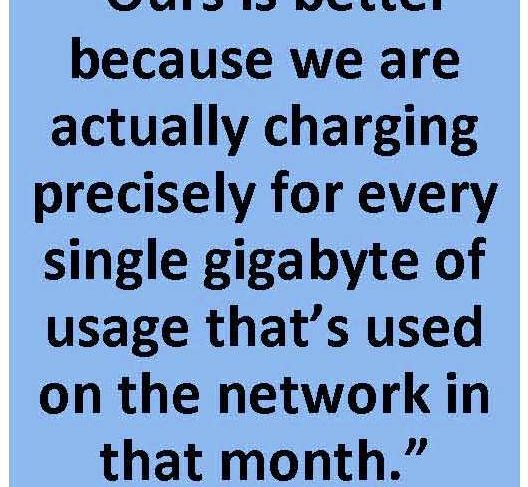
GATINEAU – Aggregated volume pricing (AVP) shouldn’t be seen as a penalty on independent ISPs, but as an incentive for them to manage their network congestion, Bell Canada told the CRTC during the first day of the re-hearing of the wholesale usage-based billing issue.
Bell argued its AVP approach is a better economic internet traffic management practice (ITMP) than the 95th percentile method proposed by the Canadian Network Operators Consortium (CNOC) because it provides returns on network investments and incents independent ISPs to reduce congestion in their networks.
“[The AVP approach] ensures that incumbents receive an appropriate return on their investments in building networks and relieving congestion; and it sends the right economic signals to wholesale users by incenting them to manage their networks in a manner that diminishes congestion,” Jonathan Daniels, VP of regulatory law at Bell said during the company’s opening remarks.
The CNOC proposal fails on a number of fronts, said Bell. It noted that 95th percentile addresses only congestion at the ISP point of interconnection, not the aggregation network. As well, this method only deals with peak traffic and not overall traffic, meaning that while peak traffic may be reduced, overall traffic could rise, resulting in congestion.
“That is not fair, nor is it effective as an ITMP,” said Daniels.
From a revenue perspective, Bell says that while both AVP and 95th percentile are designed to be revenue neutral, the fact of the matter is under the latter, usage would increase, tilting the cost recovery into the red.

Tom Little, executive VP and president of Bell Wholesale, added under questioning from commissioner Candace Molnar that using the 95th percentile approach opens the door to gaming from the independent ISPs.
“I have grave concerns that the 95th percentile would be gamed and that we would not end up at all revenue neutral. We would end up with significant usage and not significant economic benefit,” he said. “I believe that an independent ISP would have quite a motivation to manage their peak and not total usage and we would end up with low peaks and massive total usage.”
Bell was also asked to explain the advantages of AVP versus the cable companies’ proposal.
“With the goal of managing congestion, ours is better because we are actually charging precisely for every single gigabyte of usage that’s used on the network in that month,” explained Mirko Bibic, Bell’s senior VP of regulatory and government affairs. “So there is no assumed cost model, no assumed usage based on historical patterns. What you use is what you pay for, for FTTN.”
CRTC chair Konrad von Finckenstein pressed Bell on the issue of potentially providing credits or carry-overs for ISPs that don’t use the total amount of bandwidth they purchase.
Little explained the AVP scheme was designed to provide a bucket of bandwidth so that ISPs could accurately predict usage, have an incentive to manage congestion and an incentive to manage the traffic down. “In our mind we saw it as an incentive not a penalty to accurately predict usage and to try to accurately give an incentive to people to control their usage too,” he said.
“If you’ve bought in advance a certain block of traffic at a lower rate, now you have an incentive to manage to the amount you’ve bought. If you can make up the shortfall after at the same price… there’s no greater incentive to manage usage,” Bibic added, noting that this approach is well established particularly in the wireless sector.
“In retail wireless, you have in-bucket minutes and if you go over, you pay out-of-bucket minutes which tend to be higher,” he said.
Telus Corp., which also appeared on the first day of the hearing, noted that while it hasn’t adopted a UBB approach for its wholesale customers, the company isn’t against such an approach. “Usage-based billing is an economically rational way to recover traffic sensitive costs from the customers that cause them,” said Michael Hennessy, senior VP of regulatory and government affairs at Telus.
The company noted that it is “somewhat indifferent” to the UBB model used, as long as it “allows the carrier to fully recover its costs and associated risks.” It supports a volume based approach over the peak model proposed by CNOC because of implementation simplicity.

Whereas the peak model would be more complex to manage and would introduce added costs, the volume approach “requires only the measurement of total usage by ISP without the added variable of tracking an ISP’s usage by time of day,” Hennessy added.
Asked if Telus would have to follow Bell’s lead if it had wholesale customers driving a large portion of traffic – 17% of Bell’s customers are wholesale and they drive 29% of traffic – Hennessy said it’s possible.
“But you have to determine first is your network at the current point in time sufficiently provisioned so that you can manage congestion as we’re doing today. I would assume that whether or not we have a small percentage of wholesale customers or a larger percentage of customers, that the actual internet usage in the market is more or less the same,” he said.
Telus also discounts suggestions that peak usage is driving congestion. The company says the concept of peak traffic is disappearing.
“The notion of a limited in time peak is slowly becoming a thing of the past and we’re seeing high traffic lasting for an extended period of time, therefore changing the approach that you would take in dealing with it,” said Zouheir Mansourati, Telus’ VP of network technology and planning. “There are various reasons for it. One is OTT (video) obviously but there are also services that in our case we offer and that are driving the bandwidth higher.”
Day 2 of the UBB hearing will see appearances from the Canadian Internet Policy and Public Interest Centre-OpenMedia.ca, the cable companies (Cogeco Cable, Rogers Communications and Quebecor Media), CNOC, Primus, Distributel and a western Canadian consumer panel.



